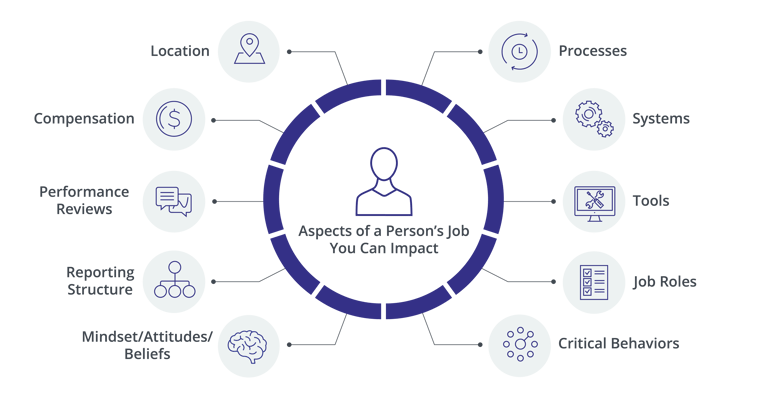Change Management for Sustainability
6 Mins
Updated: August 8, 2025
Published: January 17, 2024

Sustainability has transitioned from a "nice-to-have" to a critical business imperative. Senior leaders are increasingly tasked by shareholders and other stakeholders with developing and implementing a sustainability strategy, which requires integrating sustainable practices into the fabric of their organizations. To be successful, leaders must approach these changes strategically and at the enterprise level.
Sustainability Transformations and
Change Management
Organizations committing to sustainability can face complex, enterprise-wide and transformational change with broad impacts on their customers, people and other stakeholders. This article delves into how change management can be a potent tool in executing sustainability strategies effectively, especially for those at the helm of sustainability programs and projects.

Before we dive in, let’s briefly recap what we mean by sustainability and how it relates to organizations.
What is organizational sustainability?
In essence, “sustainability” means enduring into the future and over the long term. Whether for organizations or countries, the classic Brundtland definition of sustainable development is “Development that meets the needs of the present without compromising the ability of future generations to meet their own needs.”
In the context of organizations, this emphasizes the importance of ensuring that today’s businesses operate in a way that doesn’t jeopardize the opportunities and resources available for tomorrow’s generations.
Sustainability in organizations extends beyond environmental stewardship. It represents a commitment to operate in an economically, socially and environmentally responsible manner with a focus on the triple bottom line of planet, people and prosperity. This holistic approach aligns closely with Environmental, Social and Governance (ESG), a framework which collectively measures an organization's ethical impact and sustainability practices.
What is driving organizations to be more sustainable?
Internationally, sustainability is gaining momentum due to investor and regulatory pressures, emerging global reporting standards, evolving market demands and opportunities, skills shortages, and a growing consciousness about climate change. Increased sustainability brings with it significant benefits, including:
- Enhanced financial performance – in terms of cost reductions, revenue growth, innovation, and access to new markets and investment capital. Sustainable products and services tap into a growing market in the U.S. and U.K., as well as established markets globally where environmental and social offerings are in high demand or require strong ESG performance to do business. The sustainability challenge also spurs innovation that leads to new products, services, business models and revenue streams.
- Greater employee retention and engagement, stakeholder relations, and brand loyalty – because people, especially Millennials and Gen Z, want to have a positive impact on the world. This extends to doing purpose-driven work as well as buying products from brands that forge deeper connections with communities and stakeholders through their commitment to ESG.
- Improved operational efficiencies – from waste reduction, optimized use of resources, process improvements, and the cumulative efficiencies from streamlining at the organizational level.
- Stronger risk management, resilience and competitiveness – due to proactive measures that enable businesses to avoid penalties, minimize disruptions, and protect their reputation as focus on sustainability expands globally. Adapting to the changing landscape positions companies for long-term success while lessening the effects of external disruption or “black swan” events.
- Better alignment with global goals and initiatives – especially for larger businesses that are global or do business across multiple regions. These organizations will face greater obligations in terms of sustainability reporting where they operate, such as the European Sustainability Reporting Standards (ESRS) to comply with the EU’s Corporate Sustainability Reporting Directive (CSRD).
These and other market dynamics are compelling organizations to reevaluate and realign their operational philosophies with sustainable practices.

What are the "change challenges" in implementing sustainability projects?
Many executives are highly aware of the benefits of becoming a sustainable business. They have heightened aspirations around sustainability and ESG, and want to implement their strategy but have difficulty translating it into action. Every organization begins the journey from a different place.
From a change management perspective, success for many organizations depends on their people, customers and stakeholders “adopting and using” sustainability in the first instance. They also need people to adopt and use the technical solution delivered by each sustainability project or initiative. These are distinct change journeys, and success in one may not deliver the other.
Resistance to sustainability-oriented change is a significant hurdle. This can stem from a lack of understanding or buy-in for sustainability in principle or fear of the unknown arising from sustainability projects. Measuring and reporting sustainability outcomes can be complex, requiring new systems and processes. Retrofitting sustainability into existing business models can require a fundamental rethink of operations and strategy.
Every change or initiative may also have significant impacts on the way people do their jobs. So, despite the clear benefits, the road to sustainability involves very real change challenges.
WHITE PAPER
Sustainability continues to gain momentum as a critical business imperative across organizations. Yet many struggle with a fundamental challenge: how to move from well-intentioned goals to embedded, sustainable practices that people truly adopt?
Example of a change challenge in sustainability
To illustrate, let's look at an example of an organizational sustainability initiative in a government organization:
A government department needs to "walk the talk" in terms of its commitment to sustainability. It is operating in a location and building that offer poor energy performance and suitability for hybrid work patterns. The building design is old, resulting in 40% of the organization’s emissions and high energy costs. Staff have to deal with an uncomfortable work environment. And limited public transportation options means that most staff have no alternative but to drive to work and bear all the associated costs.
Moving to a new, sustainable building specifically designed for its needs and located close to good public transportation could bring significant benefits, enabling the organization to:
- Meet its energy efficiency, cost and emissions reduction objectives
- Deliver a better work environment to attract much needed skills
- Provide a model across the public sector for sustainability in the built environment
- Create an opportunity for staff to use different modes of transportation and reduce their travel costs
While the business case is strong, the benefits of this sustainability-oriented change depend on staff, new and old, adopting and using the building as intended. However, the change has significant impacts on people.
Consider Prosci's 10 Aspects of Change Impact model below. When you consider our example of a government organization's sustainability changes, which job aspects do you think will be most impacted?

The barriers to sustainability-oriented changes are often those that change management professionals know how to address. Removing barriers due to organizational culture, capacity for change, resource constraints, lack of executive sponsorship, and insufficient human capabilities in the business to deliver on the ambition—they’re all typical “people side” changes addressed through effective change management.
Change management emerges as a critical ally on this journey. Change management offers a structured approach to transitioning individuals, teams and organizations from a current state to a desired future state. In the context of sustainability, it involves aligning the organization’s vision and goals with sustainable practices and managing the human side of the transition.
8 Tips for Leading Sustainability-Oriented
Change Projects
It’s fair to acknowledge that sustainability has so many implications that organizations can be overwhelmed by the required changes, especially when combined with all the other significant changes they’re implementing. To address this, sustainability transformation requires an enterprise focus with attention given at both the micro and macro levels.
Tailoring change management strategies to the unique dynamics of the organization and its sustainability goals is crucial. This might involve creating cross-functional teams to champion sustainability, integrating sustainability into performance metrics, or leveraging internal communication channels to spread awareness and generate buy-in.
As you start to manage sustainability changes in your organization, consider these high-level tips:
1. Walk the talk of sustainability, and be an effective sponsor.
Employees and stakeholders will be more receptive to change if leaders model sustainability in their own actions and support associated changes through active and visible sponsorship.
2. Communicate the "why" of sustainability and your specific project clearly.
Sustainability initiatives often struggle without a compelling case for employees and other stakeholders. Explain the environmental, social and economic reasons for the change up front. Use the learnings and data from each project to reinforce the case for sustainability more broadly.
3. Harness sustainability-oriented innovation, start small, and think long term.
Big changes overnight can backfire. Use designing thinking, prototyping and experimentation to design small programs and scale what works over time. Focus on sustainable habits that endure.
4. Empower grassroots ideas through ideation campaigns.
Crowdsource solutions from employees who know their work best. Give them resources to test innovations from the bottom up. Including people in the changes that impact them is also an effective way to garner their support.
5. Make it a two-way conversation, and understand where the impacts are.
Listen to people to understand concerns about changing roles or work processes and other impacts. Address issues sincerely, and adapt your change management plan as a result.
6. Show progress and celebrate successes.
Share both sustainability and related change metrics, as well as stories and achievements that inspire continued commitment. Recognize champions openly to motivate others.
7. Support people through change.
Provide training, tools and resources, so people can adapt to new roles or routines. Offer coaching for those struggling with transition.
8. Follow a structured and intentional approach to change management.
Integrate change management with project management and solutions development from the start of every initiative. Leverage a consistent methodology and tools. And maximize your investment by developing change management competencies in your teams to manage ongoing sustainability changes and initiatives.
Change Management for Sustainability
Organizational sustainability goes beyond implementing environmental practices to encompass social responsibility and economic prosperity as well. Sustainability projects can have significant impacts on people and the ways they work, which means leading this type of transformation requires strong leadership and effective change management strategies. With the right change management tools and support, your organization can successfully navigate the journey towards your sustainability goals.
The discipline of change management is not just an enabler—it is a critical driver of sustainability in organizations. As senior leaders at the forefront of sustainability projects, your opportunity is to leverage change management principles to transform sustainability from a concept into a living, breathing aspect of organizational culture and operations. The journey is complex and challenging, but the rewards from being a more sustainable, resilient and future-proofed organization are well worth the effort.




